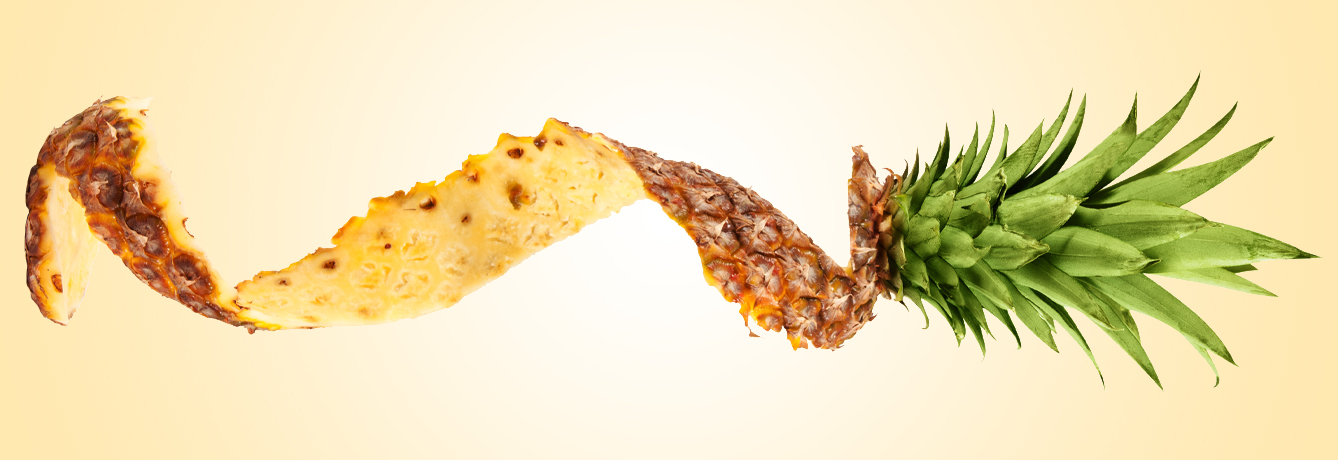To most folks, pineapple rinds are just a thorny problem – a rough exterior that needs to be carefully trimmed away to get to the juicy, sweet pulp inside. Worldwide pineapple production is estimated at roughly 17 million tons and of that just 60% is used – translating into almost 7 million tons of pineapple rinds being tossed each year.
What a waste! But wait — what if there were ways to use the rinds? Well, guess what? We found five fabulous ways to put pineapple “waste” to work:
1. JUICE ‘EM: Did you know the peels and rinds of fruit and vegetables are often the healthiest part? Kissed by sun, rinds concentrate the antioxidant protection that helps them ward off predators and help you ward off disease. So why toss “the best part” into the compost? If you own a powerful juicer you can juice the rinds (and the core) to enjoy “neat” — or mixed with other fruit and veggies. You might even try freezing the juice in ice cube trays to cool and flavor other beverages. Cheers!
2. FERMENT: Move over apple cider vinegar – how about pineapple vinegar? Place pineapple rinds and ¼ cup of brown sugar in a quart jar, covering contents with water (though leaving room at the top). Cover the jar with a lid or cloth, place out of the sunlight and let the sugar, water and rinds react for anywhere from three to eight weeks. Pineapple vinegar makes a nice dressing — but try experimenting with other recipes using vinegar.
For a twist, try “Tepache” — a Mexican brew made from fermented pineapple parts, including the rinds. Recipes vary, but most call for pineapple rinds, water, brown sugar, cinnamon and cloves. Mix it together, let nature take its fermenting course for 48 hours.
3. PINEAPPLE POTPOURRI: The smell of pineapple inspires some people to get all misty-eyed and sing “Aloha ‘Oe” and hula their way to the computer to look up roundtrip flights to the Hawaiian Islands. One way to keep that inspiration wafting through your house is to add some aloha to your usual potpourri mix. Click here to find out how to add pineapple rinds to orange, apple, pears and other fruits to make a potpourri with a Hawaiian punch.
4. PINEAPPLE FOOT TENDERIZER: Bromelain is an important ingredient in meat tenderizer, but can also be used to soften callouses and other tough skin on your feet. Instead of throwing the rinds and core and other pineapple parts away, place them in a blender or food processor and whip them into a paste. Place that paste on the rough parts of your feet and leave it there for 20 minutes while you sip your pineapple juice and watch reruns of Hawaii Five O. Rinse the pineapple paste away, and savor the softness!
5. CLEAN UP AFTER: Cutting boards can take a lot of abuse, leaving stubborn stains. But did you know you could use the pineapple rind to clean the board? Sprinkle coarse salt on the cutting board and then use the fleshy side of the rind to rub the cutting board. The pineapple juice will sanitize the board – just rinse it with warm water and dry it.
While these ideas should inspire more appreciation for pineapple rinds — it’s of course the inside that really counts. One cup of pineapple contains 130% vitamin C and 80% manganese. Fresh (and frozen) pineapple is the only known source of bromelain, an enzyme under study for support of skin and joint health. Preliminary research shows bromelain may also help reduce the inflammation associated with asthma symptoms, inhibit the growth of malignant lung and breast cancer cells, and possibly counter colitis, thus playing a role in preventing colon cancer.
Published December 1, 2013



